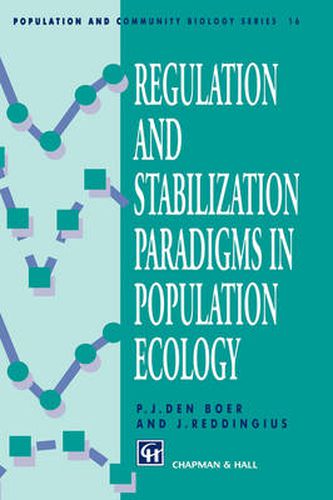Readings Newsletter
Become a Readings Member to make your shopping experience even easier.
Sign in or sign up for free!
You’re not far away from qualifying for FREE standard shipping within Australia
You’ve qualified for FREE standard shipping within Australia
The cart is loading…






This title is printed to order. This book may have been self-published. If so, we cannot guarantee the quality of the content. In the main most books will have gone through the editing process however some may not. We therefore suggest that you be aware of this before ordering this book. If in doubt check either the author or publisher’s details as we are unable to accept any returns unless they are faulty. Please contact us if you have any questions.
The problem of how population sizes are determined by regulatory mechanisms and/or various independent environmental factors has long provided a controversial and challenging issue in theoretical and applied population ecology. From a practical point of view the subject is increasingly involved in the understanding of environmental issues such as conservation of biodiversity and means of biological control. This work seeks to explain and provide an historical background to the controversies surrounding the various theoretical and mathematical standpoints on the regulation of animal numbers. The authors challenge the mechanistic approach which underpins many accepted 19th-century top down paradigms of population regulation and present the case for a less rigorously deterministic ecology and an approach to population regulation and stabilization which emphasizes life history characteristics, physiological and behavioural processes of animals. The authors are respected workers in the field and have combined their research experience to produce a stimulating volume of interest to advanced researchers in ecology, population biology and evolutionary biology. This book should be of interest to popultion ecologists, conservation biologists, entomologists.
$9.00 standard shipping within Australia
FREE standard shipping within Australia for orders over $100.00
Express & International shipping calculated at checkout
Stock availability can be subject to change without notice. We recommend calling the shop or contacting our online team to check availability of low stock items. Please see our Shopping Online page for more details.
This title is printed to order. This book may have been self-published. If so, we cannot guarantee the quality of the content. In the main most books will have gone through the editing process however some may not. We therefore suggest that you be aware of this before ordering this book. If in doubt check either the author or publisher’s details as we are unable to accept any returns unless they are faulty. Please contact us if you have any questions.
The problem of how population sizes are determined by regulatory mechanisms and/or various independent environmental factors has long provided a controversial and challenging issue in theoretical and applied population ecology. From a practical point of view the subject is increasingly involved in the understanding of environmental issues such as conservation of biodiversity and means of biological control. This work seeks to explain and provide an historical background to the controversies surrounding the various theoretical and mathematical standpoints on the regulation of animal numbers. The authors challenge the mechanistic approach which underpins many accepted 19th-century top down paradigms of population regulation and present the case for a less rigorously deterministic ecology and an approach to population regulation and stabilization which emphasizes life history characteristics, physiological and behavioural processes of animals. The authors are respected workers in the field and have combined their research experience to produce a stimulating volume of interest to advanced researchers in ecology, population biology and evolutionary biology. This book should be of interest to popultion ecologists, conservation biologists, entomologists.